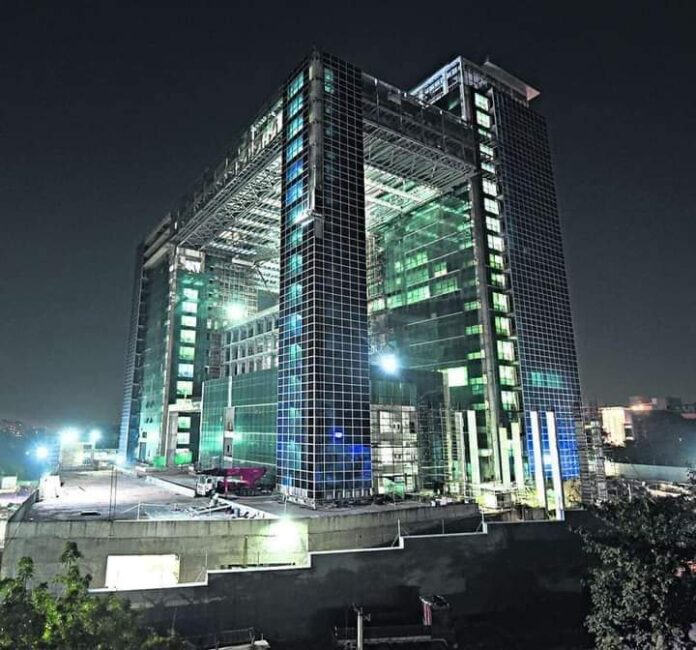Since it’s inception Telangana stands numerous uno in many areas. Now, it has got the distinction to became India’s first total surveillance state with CCTV and facial recognition technology.
The CCTV network, paired with facial recognition technology, an ever-expanding database of biometric information and a willing police force, has the potential to monitor its citizens to a worrying degree.
In May, 2021, during the second wave of the COVID-19 lockdown in India, Masood, a social activist based in Telangana, was heading home on a two-wheeler when the police asked him to pull over. He assumed they would ask for his license and other documents. Instead, he was asked to remove his face mask.
After he did, one of the policemen took out a tablet and clicked his photographs. When Masood asked why, they did not answer. But Masood said he saw several other civilians who were stopped and photographed, too.
For several days after police took Masood’s photo, he was worried about how his photos would be used. So he sent a legal notice to the police asking them about the procedure, its legality, whether these photos were being used for facial recognition, and whether the images would be stored in a database. He also sought information about the privacy of the data and accountability mechanisms in place. But there was no response. Then he filed a case against the state of Telangana, which is pending in the court.
The Indian government’s obsession with surveillance is nothing new. In 2021, the Pegasus Project, an investigation by a consortium of international journalists, revealed that the Indian government had been spying on more than 300 people, including journalists, activists, and politicians.
Telangana is the youngest state in India. It was carved out as a separate political entity in June 2014 from Andhra Pradesh. As a young state, Telangana has been eager to experiment with the use of technology. Its capital city, Hyderabad, is one of the main technology hubs in India.
Srinivas Kodali, a researcher with the advocacy organisation Free Software Movement of India, said the Telangana government has been open to allowing big technology companies to test their software there. According to Kodali, the bureaucracy in Hyderabad touts its innovation while implementing surveillance without any oversight.
Kodali said the worldwide effort to patch the Y2K bug helped Hyderabad become a global centre of technology development.
“The government back then helped local IT companies get experience in software development, and they decided to buy anything they developed. So now when they develop facial recognition systems, blockchain, and other technologies, the government happily buys it to experiment on the citizens,” he told #KhabarLive. That includes technologies in governance and policing, such as the use of facial recognition technology to find missing persons, identify the voters at polling booths, distribute rations among the lower-middle class, and issue pension certificates.
Through its “smart governance” programme, Samagram, Telangana keeps a centralised database that includes information about the employment status, personal lives (including marital status and children), and birth and death details for every citizen.
But innovation isn’t the only reason for Hyderabad’s surveillance boom. In August 2007, twin blasts killed 42 people at two crowded public places in the city. After that, there was a rise in the use of CCTV cameras. A year later, the 2008 Mumbai attack on Taj Hotel and some other landmarks led the police across India to adapt new technologies.
That also included Hyderabad, home to about half of the total Muslim population in Telangana. In 2013, terrorists struck again in Hyderabad, killing 21 people and injuring more than 100 in two powerful explosions. As an effort to modernise police, a law was enacted that required all establishments to install CCTV cameras if they attracted a crowd of more than 100 people.
Now, Telangana is one of the most surveilled states in India. The national capital New Delhi has about 33 CCTV cameras for every 1,000 people, according to a study. But Telangana’s capital city, Hyderabad, has 36 CCTV cameras per 1,000 people, making it one of most surveilled cities in the world.
There are nearly 900,000 cameras installed, most of them concentrated in Hyderabad. According to the Bureau of Police Research and Development under the Indian Ministry of Home Affairs, in January 2020, 61% of all police CCTV cameras in India were in Telangana. A study by New Delhi-based digital liberties organisation Internet Freedom Foundation found that Telangana has the highest number of facial recognition technology projects of any Indian state.
In 2021, the Internet Freedom Foundation, Amnesty International, and global human rights group Article 19 partnered to map the locations of visible outdoor CCTV infrastructure in two sampled neighbourhoods in Hyderabad: Kala Pathar and Kishan Bagh.
“Based on geospatial analysis, it was estimated that in these neighbourhoods at least 530,864 and 513,683 square meters, respectively, were covered by CCTV cameras – a remarkable total of 53.7% and 62.7% of the entire area,” the report revealed. Cybersecurity experts say the region is on the brink of becoming a site of total surveillance, where it is nearly impossible to walk without being exposed to facial recognition cameras.
Telangana’s descent into a highly surveilled state began around 2015 with cordon-and-search operations, which involve cordoning off a neighbourhood, conducting door-to-door searches, and taking fingerprint scans and photos of the citizens. Activists say this exercise usually takes place in areas where Muslims and other socioeconomically marginalised communities live.
The police also launched Operation Chabutra, in which the police detain people who roam around the streets late at night, collect and store their data, and match that against the existing criminal records. The operation draws its name from the Urdu word chabutra, meaning a raised stone platform, which is usually built in front of houses in Hyderabad. These chabutra are places where people usually sit and socialise till late in the night.
What sets these operations apart from those in other Indian states is the use of technology to collect and store data. In another style of policing, the cops randomly stop and search commuters and pedestrians, and take their photos and biometrics. That is what happened with Masood when his photo was taken by the police using an app called TSCOP. The app is equipped with facial recognition technology that can run the images through India’s national Crime and Criminal Tracking Networks and Systems in real time. The CCTNS, a project by the Indian Home Ministry, is a nationwide database that contains millions of images of criminals and missing people.
According to a report by Amnesty India, the Telangana police’s facial recognition technology scans distinct features of a person’s face to create a biometric map. An algorithm then searches for potential matches using images of people’s faces scraped from social media profiles and other databases.
The police’s practice of photographing people and taking their fingerprint scans to build a criminal database violates Indian law because India’s Identification of Prisoners Act, 1920 prohibits police from taking photographs of people, unless they are arrested or convicted of a crime. Sharing such photographs with other law enforcement agencies is also not permitted.
Anushka Jain, associate counsel for surveillance and transparency for the Internet Freedom Foundation, said that taking photos and fingerprint scans of citizens casts suspicion of criminality on the entire population. “Because by that logic, the police can argue that anybody can commit a crime and everybody should have their record on the criminal database. It goes against any established principles and constitutional rights,” Jain said.
Now, the Telangana police have built a Command and Control Centre from where all of the state’s facial recognition–capable cameras will be monitored in real time. The Command and Control Centre is supposed to be operational later in July. (Just recently, the futuristic Command and Control Centre was robbed. Unidentified men stole 38 copper wire bundles worth about $12,600 from the facility.)
The police say that the Command and Control Centre will be equipped with advanced technology to help police in reducing crime. The government claimed that during natural calamities, different state agencies would be able to monitor the situation of the affected areas and mobilise relief and rescue operations.
According to the government, if a person goes out, 50 cameras will capture them by the time they are back to their home. “The cameras cover every inch of Telangana. All these cameras will be integrated and monitored in real-time at the Command and Control Centre, which will be able to process the footage from 100,000 cameras in under a minute,” the Telangana government said in a tweet earlier this year.
India currently does not have a law for personal data protection and privacy. In the absence of a legal framework or oversight, the proliferation of CCTVs across the state—airports, polling booths, business areas, and roads—raises concerns over the limits on its use.
Under India’s newly enacted Criminal Procedure (Identification) Act, which aims to modernise the criminal justice system by linking it to technology, the police can take biometric data, biological samples, and behavioral attributes, including signatures of any arrested person. But the collection and storage of common citizens’ data and its protection worries cybersecurity experts and digital rights activists.
Though the Supreme Court of India recognised privacy as a fundamental right in August 2017, there is still not any legal framework to govern the issues related to personal data protection and privacy. A 10-member committee in 2018 submitted a comprehensive report on data protection, suggesting a draft data protection bill. A revised version is still pending before a Joint Parliamentary Committee.
It is the absence of this legal framework that worries the rights activists about how the data at the Command and Control Centre may end up being used. “It could lead to mass surveillance by the state instead of protecting civilians from crimes,” Jain said.
Kodali told #KhabarLive that he worries that what is happening in Telangana will soon spread across the country: “These are essentially experiments that are being carried out in Hyderabad so that the Indian Home Ministry can implement it across the country.”
The concerns are not unfounded. The Indian government plans to implement an Automated Facial Recognition System across the country that will be able to extract an image from a video and match it with the image of an individual whose record is already in an existing database. It will be effectively the world’s largest facial recognition system.
The major concern raised by the activists is how the entire surveillance infrastructure could be used against minorities. Historically, Jain said, “the policing system in India has been casteist and biased against certain communities. If the existing policing procedures and actions are not corrected, the existing biases and harms will also creep into these technologies.”
The Indian government and its police already have a record of using facial recognition technology in contexts where human rights are at stake. The technology was used while enforcing COVID-19 lockdowns and identifying citizens who protested against a discriminatory citizenship law. The police in New Delhi used facial recognition technology to identify farmer protesters who held demonstrations against the government’s contentious agricultural laws.
Digital rights activists and cybersecurity experts are also suspicious because of the selective use of technology. Masood said the police only cordon low-income and Muslim neighborhoods when they take credentials from people. “I have observed that the police do not take fingerprint scans or photographs in high-income societies,” Masood told #KhabarLive.
It is because of this bias that Masood said there is a possibility the whole surveillance infrastructure may be used against Muslims and Dalits—outcaste Hindus, or “untouchables”—in the future. “The way the Israeli government uses facial recognition technology against Palestinians, we are worried it might happen to us as well. … There is a possibility this whole infrastructure could be used against minorities in [the] future.” Masood said. #KhabarLive #hydnews







